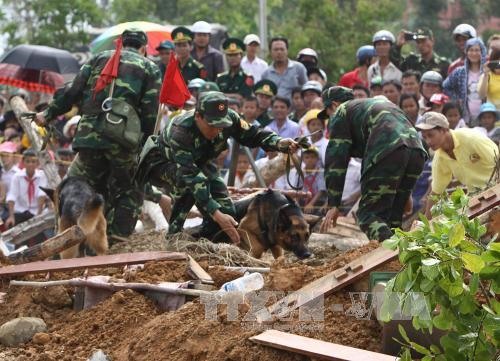 Society
Society

A vocational school in Vĩnh Yên City in the northern province of Vĩnh Phúc is training canines that are used as a special force to seek and rescue people if any incident, accident or natural disaster occurs.
 |
| A police dog at the school in his training course. — VNA/VNS Photo Dương Giang |
HÀ NỘI — Đặng Hùng Sơn, Sub-lieutenant of Border gate Vocational School No 24 in Vĩnh Yên City in the northern province of Vĩnh Phúc, spends eight hours a day befriending, caring for and training his four-paw student.
Sơn is one of the school’s instructors of canines that are used as a special force to seek and rescue people if any incident, accident or natural disaster occurs.
Sơn’s pupil is a police dog named Tosy. Sơn and Tosy often spend about four hours on training daily together even in the hottest summer days or the coldest winter days.
Sometimes, the lesson is finding the target. Sơn plays a victim that has gotten stuck in a dark tunnel. Or he wears a mask with an oxygen tube and hides under the heavy mud and Tosy is assigned to find Sơn. Sometimes, Sơn teaches Tosy how to recognise special smells so that Tosy could find heroin or gunpowder.
Sơn says apart from giving his student lessons daily, he also takes Tosy for walks, grooms Tosy and communicates with Tosy.
“Sharing this time together will help me and my student become closer every passing day,” he tells Thanh niên (Young People) newspaper.
“It’s very helpful for the training,” he adds, explaining that he is able to determine Tosy’s special characteristics. .
Đoàn Văn Hoàn, Sub-lieutenant, is tasked with training another police dog named Pocka.
“Pocka and me do not have a relationship like that between an instructor and a police dog, we are friends,” Hoàn says.
Once when Pocka had a fever, Hoàn took him to a veterinarian for treatment. When Hoàn was going to back to his school and Pocka had to stay at the clinic, Pocka showed signs of wanting his teacher to stay.
“So, I stayed at the clinic with him that day, feeding him porridge and milk.”
Tosy and Pocka are the two best police dogs at the school, selected from dozens of potential candidates after two years of tough training courses.
The two police dogs helped the rescue team discover the body of Aiden Shaw Webb, a British tourist, on June 9, 2016. Webb went missing while climbing the
Careful selection
Nguyễn Xuân Phương, vice principal of the school, says the dogs’ parents are often imported from
When the puppies are just over three months old, instructors select the puppies with the best sense of smell to attend the first training course. Typically, only 20 per cent of the hundreds of puppies are chosen for the course.
The first course is designed to provide the dogs skills to obey orders from the instructors, including standing, lying, sitting, barking, holding an object and coming back when an instructor calls.
When the first training course finishes, the top candidates are picked to participate in the intensive training courses. Dogs with good nervous systems will be trained to fight crime and protect the targets. Dogs with good sense of smell will receive training to discover heroin and gunpowder as well as to rescue victims during incidents, accidents or natural disasters.
Each police dog often serves about 10 years.
Đào Duy Hà, head of the police dog management team, says the course of training police dogs was launched in 2006. One year later, the first couple of police dogs named Altop and Poma found 11 victims who were buried in a stone quarry collapse in the central
Hà said at that time, after all the most modern metal detectors failed to seek cranes with the hope of discovering the victims, who might drive or work near the cranes, the two police dogs were dispatched to the scene.
“They did their job very well,” he said. They found 11 places with human smells.
Then, their human owners could dig, remove the stones from the right places and remove the bodies of the victims, with the cost of VNĐ2 billion (US$88,600) for using supporting machines, he says.
If the police dogs did not discover the victims, they would have had to use cranes to remove all soil and stones to find the victims. It would cost about VNĐ30 billion ($1.3 million) to operate supporting devices and machines to remove the soil and stone over dozens of days, Hà says. — VNS




